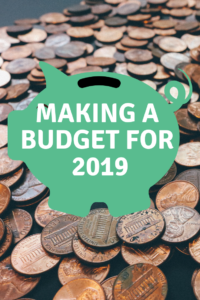Odds are that life is going to continue getting tighter for many of us. Now is the perfect time to turn over a new leaf and get your finances under control. The first step to do that… Making a Budget! It can be overwhelming to even know where to start, but it’s really not that tricky. Let’s lay out exactly how to make a budget and what a budget can look like for you.
Before You Start
The important foundation of making a budget is to figure out your why. The “why” of your budget isn’t necessarily going to be the same as your best friends. For us, at one point our biggest reason for having a budget was to manage our money in order to pay off student loans. Once those were paid off, our focus shifted to managing our money so that we could afford to live on only my husband’s income. What is your goal? What is important to you?
When you have a goal or a “why,” you can refer back to it every time you consider purchasing something outside of your budget and remember the greater reason for having your budget. Every unplanned purchase is going to come out of some place in your budget, and while sometimes that’s fine, it that can help you make better decisions about how you spend your money.
How to Make a Budget
The first official step in making a budget is to make a list of all of your monthly expenses. Then, add big expenses that happen less often but are predictable, like car taxes, insurance payments, or healthcare deductibles.
If you need some more help getting started on this part of budgeting, download Dave Ramsey’s FREE Guide to Budgeting.
Let’s pretend you’re making a budget and your family income is $45,000/year, or about $3,750 after taxes. Using figures averaged across several financial experts, the following percentages are a good place to start when trying to figure out a good amount to set aside in your budget. Of course, we can’t go into all the nuances of each person’s situation—maybe you have a family of 6, so your food costs are higher, but you have health insurance through one spouse’s job, so you don’t have to pay that. Your budget should work for YOU and match YOUR priorities.
- Housing/household purchases: 25%
- Food: 12%
- Utilities: 7%
- Charity: 10%
- Transportation: 10%
- Clothing, entertainment, etc.: 4%
- Medical/health insurance: 7%
- Miscellaneous: 5%
- Savings/debt repayment: 20%
Using those percentages yields the following amounts:
| Category | Monthly amount |
| Housing (mortgage/rent, taxes, insurance, repairs etc.) | $937.50 |
| Food/groceries | $450 |
| Utilities (electric/water/sewer/phone/internet/cable) | $262.5 |
| Charity/giving | $375 |
| Transportation (gas, insurance, taxes, repairs) | $375 |
| Clothing, entertainment, etc. | $150 |
| Medical bills/health insurance | $262.50 |
| Miscellaneous | $187.50 |
| Debt payments/savings | $750 |
| Total | $3750 |
Other categories you may need to include: child care expenses, retirement contributions, kids’ activity fees.
Budgeting isn’t easy. It forces you to look at your needs vs. wants and maybe make some cuts in your lifestyle. You may calculate the amounts based on the above percentages and realize that you spend more on transportation due to your commute. Maybe that means you need to re-examine your grocery spending.
The important thing is to give every dollar a job. The percentages aren’t magic—they’re just a guide—but it is important to make sure you don’t have extra dollars floating around without a plan for them. If you skipped the percentages and just put in your average spending and ended up with $600 left over, figure out what that $600 needs to do! Maybe you want to give more money to charity. Maybe you have a big trip coming up that you can start socking money aside for. Or maybe you can make an extra payment toward the principal on your mortgage. If you give every dollar a job, you’re less likely to have your money slowly trickle out on small, nonessential items.
Using Your Budget
Making a budget is only helpful if you use it, so remember to keep it simple. There is no need to have a separate category for bath tissue. Just put it under household. If you add purchases in as you go or use cash, the overall time you spend on it each month will be minimal.
If you’re married, consider having a monthly “budget meeting” over coffee or ice cream with your spouse. Look at your spending over the past month and talk about how your priorities have changed or if your spending needs to change. This can be an argument waiting to happen for some couples, so try a few things to help make it happier (the longer you keep your budget the more this is just a fun date night I promise).
- Set a value that if something you want costs more than $X you have to ask the other one about it. We set ours to $25 which may seem low, but we found that the small purchases were what was adding up fast! Note, this is just for wants not for groceries and other needed items.
- Put a sheet of paper on the back of your door for larger things you want. When something has been on the list for 30 days and you have the money then now is the time to start finding a deal. This keeps you from impulse buying, and many times you’ll find you’ve scratched out the item and added something different below it.
- When the budget categories don’t add up and areas need to be cut, try to each come to the table with things you can give up. Don’t start attacking their spending but be willing to slash your own first.
- Be reasonable! To tell someone they have a $0 clothing budget for the year isn’t going to work. Maybe you set a family challenge to get things you need from thrift first, but you will end up spending money in all the major categories above.
As you move forward, remember that your income needs to at least match the amount of money that is going out. If you can’t make the ends meet, you’re not allowed to use credit to make up the difference. You’re going to have to make the tough cut-backs and remember the difference between needs and wants. If you can put it on a list and wait 30 days to ponder if you really want to buy it, it’s officially a want. (Please don’t put bath tissue on that list!)
Need help getting started on cutting your expenses?
Budget Programs and Apps
Looking for a program to to help make a budget? There are some great free options, some of which include apps for your smartphone. One of the most popular free options is Mint.com. Dave Ramsey’s EveryDollar program is also free, although you’ll have to pay for the upgrade that allows you to connect bank accounts. Using a pen and paper or a spreadsheet is also free, of course!
Quicken Deluxe is another popular personal finance tool and only costs $30 for the first year. Pearbudget is a lesser-known but extremely simple budgeting program that is based on giving every dollar a job, and it costs $4.95/month after a 30-day trial. They also have a free spreadsheet template you can download to use for your budget.
Another favorite is YNAB, which is not free ($84/year) but is great for beginners and teaches you to live on last month’s income. You can try it free for 34 days, and they also have free, live classes.
If your family is in debt or you want to learn more about finances, I highly recommend Dave Ramsey’s books, Total Money Makeover and Financial Peace. Whatever your goals are, knowledge is power. The more you know, the better decisions you can make, so educate yourself.
See more frugal living tips.



